September 2022
A Frenchman Fascinated by Sakai Knives
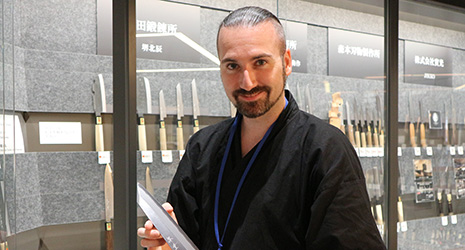
Eric Chevallier holding a kiritsuke, or cutting knife, which can be used for a variety of purposes 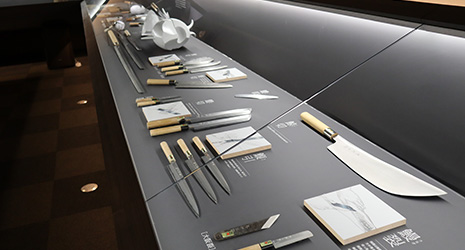
An exhibit showing various knives, each shaped differently depending on their use for fish, meat, vegetables and so on
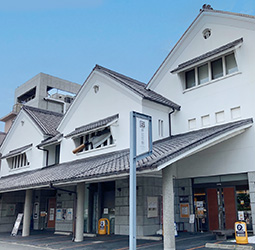
The Sakai City Traditional Crafts Museum in Sakai City, Osaka Prefecture 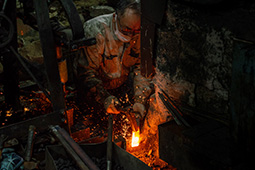
A bladesmith forging a knife 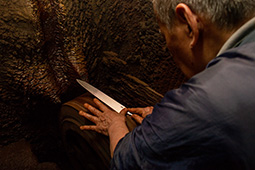
A bladesmith sharpening a knife

Having gained experience as a kaji* bladesmith, French-born Eric Chevallier today shares knife-based elements of traditional Japanese culture with the world as the inbound coordinator for Sakai City in Osaka Prefecture.

The Mozu-Furuichi Kofun Group**, a collection of 44 kofun, or mounded tombs, built between the late 4th century and early 6th century, gained World Heritage listing in 2019. The group includes the Daisenryo Tumulus, one of the largest mounded tombs in the world with a mound length of approximately 500 meters, which lies in the center of Sakai City. Facing Osaka Bay, Sakai prospered greatly as a hub of overseas trade in the Middle Ages. Various forms of craftsmanship have thrived in Sakai for centuries, and those traditions have been passed down to the craftspeople of Sakai in modern times. In particular, its knives are of such renown that almost all the knives used by professional chefs in Japan are believed to have been made in Sakai.
The Sakai City Traditional Crafts Museum, which showcases the traditional industries of Sakai, devotes its first and second floors to knives, with rows of exhibits demonstrating the wide variation in the knives produced by each craftsperson. Stationed on these floors to provide guidance is French-born Eric Chevallier.

In addition to his mother tongue of French, Chevallier is also fluent in English and Japanese. “The history of Sakai knives goes far back, originating from the craftspeople who were assembled to construct the mounded tombs. The greatest appeal of a Sakai-made knife is that its sharpness will not diminish for more than fifty years with maintenance. On top of that is the surprising variety of Sakai knives each with their own particular uses,” Chevallier explains.
In fact, Chevallier has accumulated around five years of study as a bladesmith under Sasuke, a knife and scissors smith in Sakai that has been in business for around 160 years. His solid experience and knowledge earned recognition, and since 2018 he has been assigned to the Sakai City Traditional Crafts Museum as the Foreign Market Development Coordinator of the Sakai City Industrial Promotion Center.

In part due to washoku (traditional Japanese cuisine) being registered as a UNESCO Intangible Cultural Heritage*** in 2013, there has been increased interest in Japanese knives from chefs overseas. Since 2018, Chevallier has shown countless overseas visitors around the Sakai City Traditional Crafts Museum, and sales of knives in the museum in that time have doubled. Chevallier’s ability to carefully respond to sophisticated questions and requests from professional chefs from Japan and abroad has earned him great trust at the museum.
Born and raised in Paris, Chevallier had an interest in Japanese culture from an early age and studied in the Japanese language department of the National Institute of Oriental Languages and Civilizations (INALCO) at the Paris-based Sorbonne University. During that time, he developed an interest in the mounded tombs of Japan he learned about in class, and made his first journey to Sakai City in 2012. It was at this time that he formed a connection with the aforementioned Sasuke, which has carried out a number of solo exhibitions of its products in France. He started out by assisting with interpreting, but in the course of visiting the Sasuke worksite, he became fascinated by kaji bladesmithing, and enrolled in an apprenticeship. Chevallier started with the basics, following tradition at Sasuke by cleaning the work area and arranging the altar each day. A little at a time, he learned by watching his master work up close.

While Chevallier explains that “the blades of scissors are complex and delicate, and the techniques cannot really be mastered in five years or so,” he improved enough that his master recognized his skill, telling him, “if it’s a knife, you are good enough to put your own name on it.”
“As a bladesmith, I still have that passion of wanting to forge a knife,” says Chevallier. “But I also want people to know that the traditions of Sakai knives continue to live on through the unique elements of Japanese culture in which the knives are used, such as Japanese cuisine and bonsai,” he continues, revealing his commitment to explaining the products both to visitors and by disseminating information through blogs and social media in his capacity as inbound coordinator.
Sakai knives are made using a large number of traditional techniques that continue to be preserved by local craftspeople. To safeguard the knife-making tradition that so fascinated him, Chevallier aspires to embrace the task of “communicating to the world the charms of Japanese culture that are still not well known.”
* The manufacturing of various types of utensils by heating and tempering metal.
** See Highlighting Japan September 2019 Issue: “A Journey Connecting the Bustling City of Osaka to World Heritage Sites” https://www.gov-online.go.jp/eng/publicity/book/hlj/html/201909/201909_13_en.html
*** See Highlighting Japan April 2014 Issue, "Aiming for a greater share of the global market: Interview with Masayuki Yamashita of the Ministry of Agriculture, Forestry and Fisheries” https://www.gov-online.go.jp/eng/publicity/book/hlj/html/201404/201404_02_en.html

